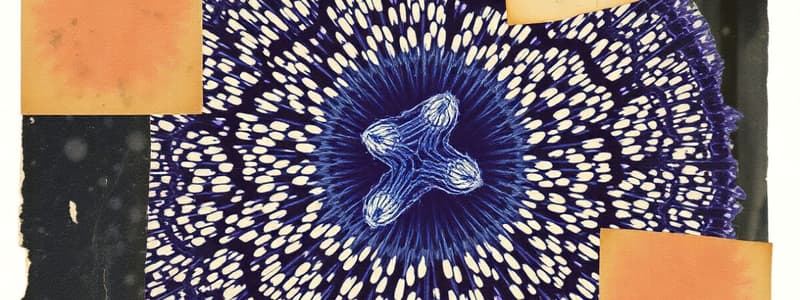Podcast
Questions and Answers
What is the primary purpose of the material presented?
What is the primary purpose of the material presented?
Which of the following could be a possible limitation of the content provided?
Which of the following could be a possible limitation of the content provided?
How might the material influence critical thinking skills?
How might the material influence critical thinking skills?
What could be a suitable follow-up action after engaging with the content?
What could be a suitable follow-up action after engaging with the content?
Signup and view all the answers
Which characteristic best describes the intended audience for the content?
Which characteristic best describes the intended audience for the content?
Signup and view all the answers
Study Notes
Microscopy
- Microscopes magnify images, making them appear larger than their actual size
- Magnification = (image size) / (actual size)
- Light microscopes have a maximum magnification of x1500
- Electron microscopes have a maximum magnification of x500,000
- Resolution is the ability to distinguish between two separate points
- Light microscopy resolution is 200nm.
- Electron microscopy resolution is 0.5nm.
Types of Electron Microscopes
- Transmission electron microscope (TEM) can see internal structures and has a resolution of 0.5nm.
- Scanning electron microscope (SEM) shows 3-D appearance and has a resolution of 3nm-20nm.
- TEM allows 2-D visualization, while SEM allows 3-D visualization.
Cell Structure
- Plant and animal cells have different organelles
- Animal cells do not have a cell wall, while plant cells have a cell wall (cellulose).
- Both plant and animal cells contain a nucleus, mitochondria and endoplasmic reticulum, (both rough and smooth).
- Plant cells contain choloroplasts, while animal cells do not.
The Nucleus
- Largest organelle in a mammalian cell
- Surrounded by a double membrane (nuclear envelope) with pores
- Contains DNA, RNA, and proteins
- The nucleolus produces ribosomes
- euchromatin (light) or heterochromatin (dark)
Membranous Organelles
- Endoplasmic Reticulum (ER) - Both rough (RER) and smooth (SER)
- RER has ribosomes attached
- SER synthesizes lipids and steroids and breaks down toxins
- Golgi apparatus/body - modifies and packages proteins and lipids.
- Lysosomes - contain enzymes to break down materials.
- Vacuoles - store liquid
- Vesicles transport substances within a cell
Ribosomes
- Non membranous organelle
- Made of two subunits
- 80S (eukaryotic cells) and 70S ribosomes(both prokaryotic and eukaryotic - in mitochondria and chloroplast)
- Involved in protein synthesis
Mitochondria
- Double-membraned organelles
- Inner membrane is folded into cristae
- Contains DNA and ribosomes
- Involved in aerobic respiration and ATP production
Chloroplasts
- Double-membraned organelles
- Contain chlorophyll, circular DNA and ribosomes
- Site of photosynthesis
Cilia and Flagella
- Hairlike extensions in eukaryotic cells
- Cilia are hair-like, short, while flagella are whip-like, long
- Composed of microtubules arranged in a 9+2 pattern
- Microtubules (MTDs) are arranged in the 9+2 array
- involved in movement
Microvilli
- Finger-like projections on the cell surface
- Increase surface area for absorption
- Composed of actin filaments
- Found in small intestine and proximal convoluted tubules (kidneys).
Cellulose Cell Walls
- Rigid layer in plant cells
- Made of cellulose microfibrils
- Provides strength and support
Cell Sap Vacuole
- Membrane-bound sacs found in plant cells
- Store water, waste products, and other substances
- Maintains turgor pressure
Centrosomes
- Microtubules organizing center (MTOC)
- Composed of centrioles
- Assists in cell division
Carbohydrates
- Monosaccharides- (simple sugars) - e.g. glucose, fructose and galactose.
- Disaccharides - two monosaccharide molecules e.g. sucrose
- Polysaccharides - multiple monosaccharide molecules e.g. startch, glycogen, cellulose.
Lipids (Fats/oils)
- Triglycerides are made from glycerol and fatty acids
- Phospholipids have a hydrophilic head and two hydrophobic tails.
- Cholesterol is made of four carbon rings, a small part is hydrophilic
Proteins
- Proteins are macromolecules
- Made of amino acids, which have different R-groups giving each its uniqueness
- There are 20 different amino acids in total, e.g. glycine
Enzyme Action
- Enzymes are globular proteins that act as biological catalysts of reactions
- Enzymes have specific shapes of active sites
- Substrates (reactants) bind to the active site through weak interactions.
- Enzyme-substrate complexes forms and lower activation energy for the reaction.
- Factors affecting enzymes: Temperature, pH, substrate concentration, enzyme concentration, & inhibitors
Membrane Transport Mechanisms:
- Simple Diffusion - passive transport of small molecules across the cell membrane down a concentration gradient.
- Facilitated Diffusion - passive transport of molecules aided by protein channels.
- Active Transport - the movement of molecules across a membrane against their concentration gradient; using energy in the ATP form
- Endocytosis and exocytosis - bulk transport of large particles or fluids into or out of the cell (using ATP)
Studying That Suits You
Use AI to generate personalized quizzes and flashcards to suit your learning preferences.
Related Documents
Description
Test your knowledge on microscopy techniques and cell structures. This quiz covers light and electron microscopes, their magnification and resolution, as well as the differences between plant and animal cells. Explore the fascinating world of cells and their organelles!




